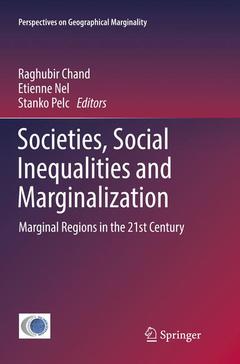Societies, Social Inequalities and Marginalization, Softcover reprint of the original 1st ed. 2017 Marginal Regions in the 21st Century Perspectives on Geographical Marginality Series, Vol. 2

This book provides an overview of marginality or marginalization, as a concept, characterizing a situation of impediments ? social, political, economic, physical, and environmental ? that impact the abilities of many people and societies to improve their human condition. It examines a wide range of examples and viewpoints of societies struggling with poverty, social inequality and marginalization.
Though the book will be especially interesting for those looking
for insights into the situation and position of ethnic groups living in harsh mountainous conditions in the Himalayan region, examples from other parts of the world such as Kyrgyzstan, Israel, Switzerland and Finland provide an opportunity for comparison of marginality and marginalization from around the world. Also addressed are issues such as livelihood, outmigration and environmental threats, taking into account the conditions, scale and perspective of observation.Throughout the text, particular attention is given to the context and concept of ?marginalization?, which sadly remains a persistent reality of human life. It is in this context that this book seeks to advance our global understanding of what marginalization is, how it is manifested and what causes it, while also proposing remedial strategies.
Raghubir Chand’s primary research interests are in mountain geography with regard to the Himalayan environment and landscape ecology, socio-economic and demographic transformation of Himalayan societies, migration studies, agricultural productivity, cultural geography, environmental and livelihood support systems of tribal communities of Bhutan and other parts of the western Himalayas. He has published three books including Brokpas: The Himalayan Highlanders of Bhutan (2004) and Globalization and Marginalization in Mountain Regions (Springer, 2016). He has published 80 papers in various national and international journals. Further, he serves on the editorial board and is one of the founder members of PAHAR—a research journal of the People’s Association for Himalaya Area Research based in Nainital, India.
Etienne Nel has research interests in regional, local and community economic development. He is currentl
y the Managing Editor of the journal New Zealand Geographer and the Commissioning Editor for the journals Local Economy and Journal of Geography in Higher Education. He has edited/authored eight books and is currently engaged in two book projects with Routledge.Stanko Pelc has been involved in rural development and planning of transportation systems; at present, he teaches at the geography department as well as at the departments of pre-school and primary education. His research interests cover many different fields such as demography, transportation geography, local and regional development, marginality and marginalization, especially its social dimension and in the educational context. He has edited two books; he is the author of one book and one university textbook (all in Slovenian) and has contributed several chapters to books in English/German. He has recently published an online book about Slovenia’s urban population.
Advances and refines the concept of marginality
Reveals different examples of societies living in marginal conditions and the variable impacts of globalization
Features case studies mainly from the Himalayan region on a wide range of topics that reveal different perspectives on marginality and marginalization
Includes supplementary material: sn.pub/extras
Date de parution : 05-2018
Ouvrage de 311 p.
15.5x23.5 cm
Disponible chez l'éditeur (délai d'approvisionnement : 15 jours).
Prix indicatif 116,04 €
Ajouter au panierDate de parution : 04-2017
Ouvrage de 311 p.
15.5x23.5 cm
Disponible chez l'éditeur (délai d'approvisionnement : 15 jours).
Prix indicatif 116,04 €
Ajouter au panier


